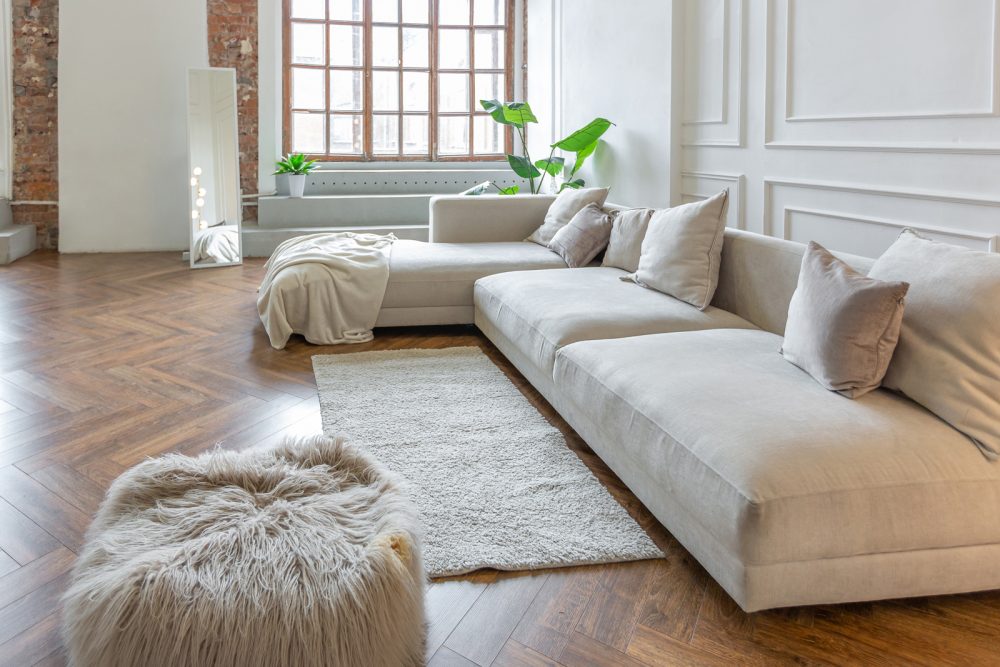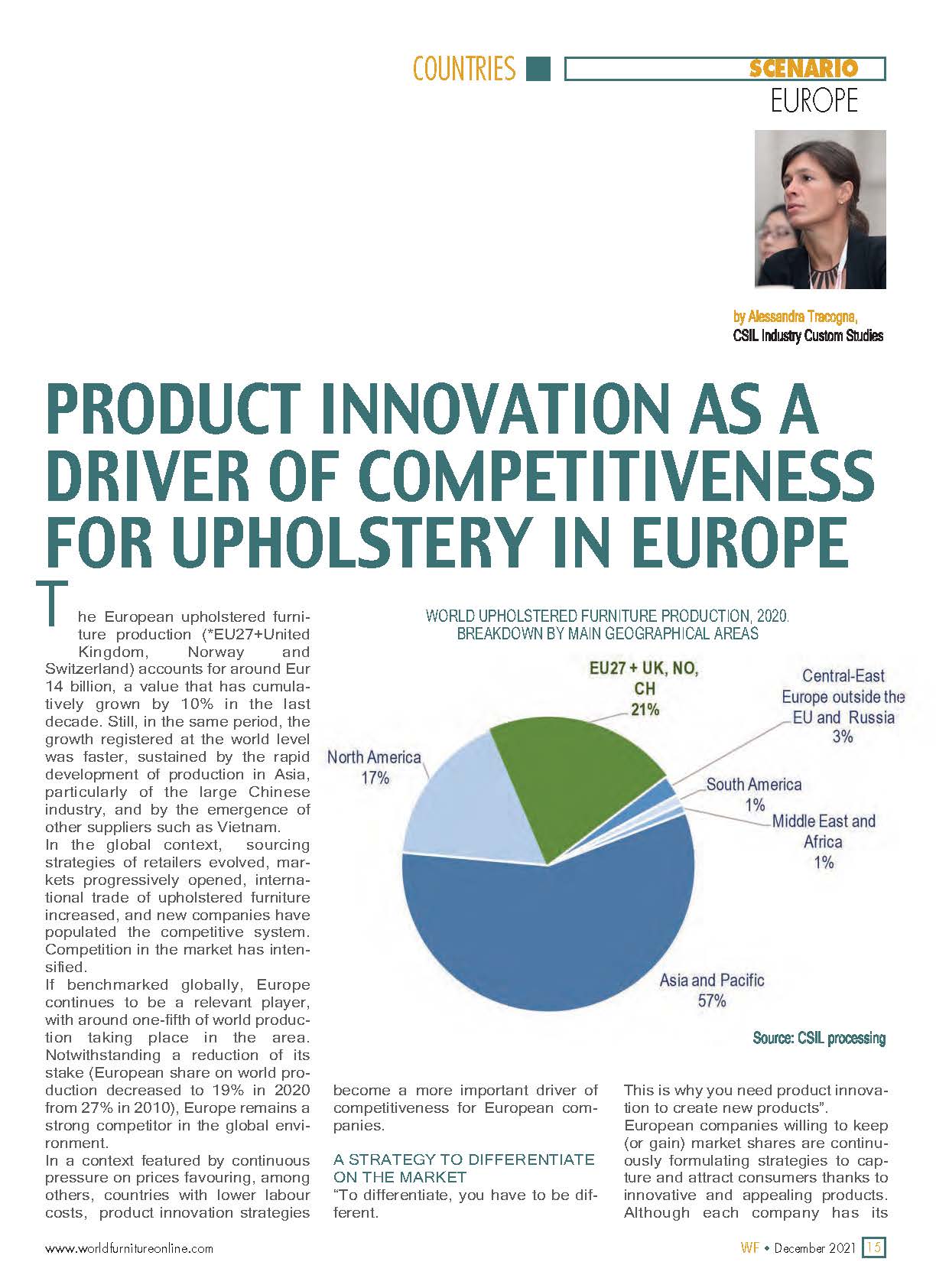Product innovation: driver of competitiveness for upholstery in Europe


According to CSIL, the European upholstered furniture production (*EU27 + United Kingdom, Norway, and Switzerland) accounts for around Eur 14 billion, a value that has cumulatively grown by 10% in the last decade.
Still, in the same period, the growth registered at the world level was faster, sustained by the rapid development of production in Asia, particularly in the large Chinese industry, and by the emergence of other suppliers such as Vietnam.
In the global context, sourcing strategies of retailers evolved, markets progressively opened, international trade of upholstered furniture increased, and new companies have populated the competitive system.
Competition in the market has intensified. If benchmarked globally, Europe continues to be a relevant player, with around one-fifth of world production taking place in the area. Notwithstanding a reduction of its stake (European share on world production decreased to 19% in 2020 from 27% in 2010), Europe remains a strong competitor in the global environment.
In a context featured by continuous pressure on prices favouring, among others, countries with lower labour costs, product innovation strategies become a more important driver of competitiveness for European companies.
A STRATEGY TO DIFFERENTIATE IN THE MARKET
To differentiate, you have to be different. This is why you need product innovation to create new products.
European companies willing to keep (or gain) market shares are continuously formulating strategies to capture and attract consumers thanks to innovative and appealing products.
Although each company has its unique vision, market positioning and product offer, the common denominator is their willingness to differentiate from competitors.
Companies are focusing on expanding at the maximum the personalization options offered for each product. Consumers are put at the centre, making them the real protagonist: with an idea of the sofa in mind satisfying their specific feelings and dreams, they should find it by choosing among a myriad of colours, coverings, styles, functions, etc.
Retailers never have to say no to a client’s request, but this adds complexity to the production process of manufacturers and requires dedicating considerable resources to attentive product development. Other companies are more function-oriented.
Sofa design certainly plays a role, but the emphasis is put on adding functions to the sofa. Time and resources are devoted to putting innovation in mechanisms. Mechanisms are not directly visible to consumers, but they perceive comfort. Therefore, investment in this field is considered crucial. The concept of modularity of sofas is also an element of differentiation.
The creation of products that adapt to evolving consumers’ habits and needs and to changing living spaces by expanding at the maximum product modularity and multi-functionality follows a market trend. This trend is even accentuated in the COVID era.
Another identified driver of product innovation is certainly circularity and sustainability. Creating long-lasting products (with timeless design) and products that can enter the circular economy is undoubtedly a challenge but also an opportunity in the views of innovative companies.
PRODUCT DEVELOPMENT PROCESS
The product development process is the result of interactions of human resources and know-how keeping a constant dialogue on how to develop the best possible product option The inventor of a new sofa is also someone that in their private life sits on a sofa…
The R&D and technical departments conceptualize and concretize innovation into products. The prototype department tests them, the production department shares ideas on how to improve the product in view of its industrialization (how to increase production efficiency, reduce waste..), the purchasing department proposes new solutions, thanks to its contacts with suppliers, the sales department evaluate if products can be sold (do they meet market demand?) where and at which prices and, finally, each single employees could potentially share views on the needs that a new sofa can respond to.
The process often spreads out of companies’ boundaries. External designers play a pivotal role, particularly when dealing with fully new design concepts. Collaboration with component suppliers is also important, particularly when companies are developing something fully new from a technical Sometimes, the cooperation with large and important components suppliers is (more) expensive, but it helps build the company’s reputation.
PRODUCT DEVELOPMENT TIMING IS SHORTENING
We aspire to be as quick as the fashion industry in adapting the design and product development.
The product development process (from design to industrialization) can take from a few months up to two years, varying from company to company and depending on the product complexity. Companies are making efforts to make the process smoother and more efficient thanks to technology (e.g. virtual prototyping, 3d printers, etc.).
HOW TO MEASURE THE SUCCESS OF PRODUCT INNOVATION?
You can see the success of an innovation in the face of the retailer. If he is astonished, well done!
Basically, success is measured by the performance of the product on the market. To stimulate the interest of both retailers and consumers, manufacturers have to offer something new (or something cheaper…).
Thus, sales performance is a key indicator of the success of innovation. In other words, how many consumers have the new product at home? Patenting activity is also considered a tool with some relevance. It demonstrates that what has been developed is useful and that that innovation is different from the existing ones.
LOOKING AHEAD
How will product innovation respond to new emerging needs? You arrive home tired, arms and legs are tired…you want a chair that massages your body, and you want that the chair knows that this is exactly your preference at that moment…
Upholstered furniture must be comfortable; this is the basic need. But more and more, the research will also address other needs of people that experience the products. Product innovation is not confined to research in style and design, but it also means adding functions adapting to new usages.
The usage we make of sofas has continuously evolved. While in the past families grouped to watch TV altogether (sofa had to be designed so that everyone sitting could see the screen) now different persons can sit simultaneously to work, use devices, have dinner etc.
The presence of products incorporating multi-functionality and modularity will undoubtedly increase, particularly in sofas. Not only sofa modules will be displayed in different ways, but they will be transformable (e.g., into rigid surfaces that can be used for different scopes, for example, working from home).
Sofa mechanisms will be smarter, with remote control, sensors to measure wellbeing and breathing activities, vocal commands, better and more sustainable batteries etc. At the same time, product safety rules (EU directives) will gain importance, and product development will be directed to meet these requirements.
From an aesthetical point of view, research will go towards lighter, smaller, and invisible mechanisms impacting less on sofa style and design. Sofa that should accommodate consumers and shape the human body with harmonious comfort management will also be developed.